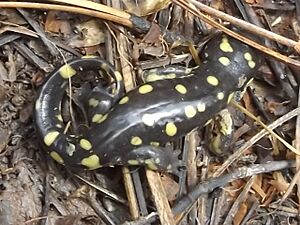Tarahumara salamander facts for kids
Quick facts for kids Tarahumara salamander |
|
|---|---|
 |
|
| Conservation status | |
| Scientific classification | |
| Genus: |
Ambystoma
|
| Species: |
rosaceum
|
The Tarahumara salamander (Ambystoma rosaceum) is a type of mole salamander. It lives in fresh water and belongs to the family Ambystomatidae. This salamander is found only in Mexico.
It lives in many different places. These include cool temperate forests, warm and wet montane forests, and high-altitude grasslands. You can also find it near rivers, fresh water marshes, and ponds. It even lives in areas where animals graze.
The Tarahumara salamander might actually be two different species. They are separated by the Sierra Madre Occidental mountains in northwestern Mexico. The IUCN Red List says it is of "Least Concern". This means it is not currently in danger. However, its home is shrinking. Also, new fish that eat salamanders are a problem. More farming in the area also threatens it. The Government of Mexico gives it "Special Protection."
Contents
What Does the Tarahumara Salamander Look Like?
The Tarahumara salamander is a medium-sized animal. Its body, from snout to vent, can be about 80 mm (3.1 in) long. Its tail can be about 73 mm (2.9 in) long. Female salamanders usually have longer bodies. Males tend to have longer tails.
Colors and Changes
When they first hatch, the larvae are brownish-black. Older larvae have yellow and black spots. Most adult salamanders that live on land have large yellow spots or streaks. These are on a dark background. Some adults are just plain in color.
Some salamanders stay in their larval form. They keep their gills and live in water. This is called paedomorphosis. They do not change into land-dwelling adults. This often happens in mountain streams and ponds.
Where Do Tarahumara Salamanders Live?
The Tarahumara salamander lives only in Mexico. It is found in the Sierra Madre Occidental mountain range. They live at high places, from 1,675 to 3,100 meters (5,495 to 10,171 ft) above sea level.
Finding Homes in Different Places
You can also find them in a small part of Arizona. This is in the Huachuca Mountains within the Coronado National Forest. Here, a border barrier is a threat to them. This salamander can live in many different environments. It usually lives in pine forests. It also lives in pine-oak forests. It likes small, slow-moving streams. Springs and ponds are also good homes.
Sometimes, they live in thornscrub areas. They can also be found in tropical forests. On farms and ranches, they sometimes breed in cattle ponds.
Current Status and Protection
The IUCN lists this salamander as "Least Concern". This means its population seems to be steady. It lives in a wide area. Scientists believe there are many of them. Its numbers are not dropping quickly enough to be listed as more threatened.


